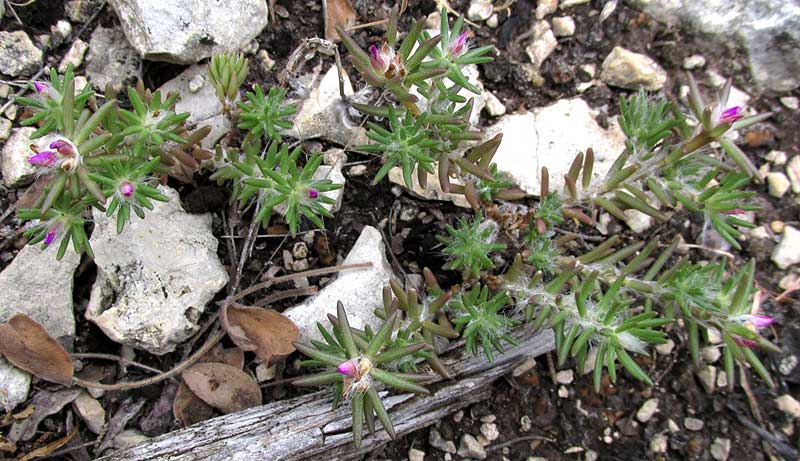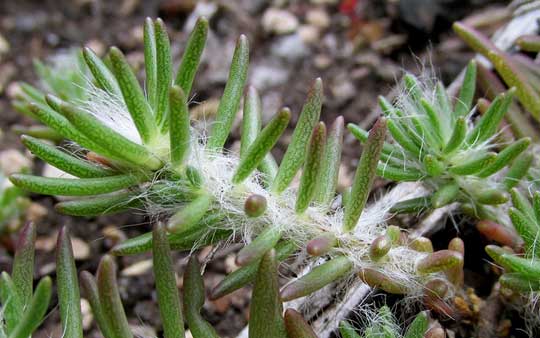Excerpts from Jim Conrad's
Naturalist Newsletter

from the July 27, 2014 Newsletter issued from the Frio Canyon Nature Education Center in the valley of the Dry Frio River in northern Uvalde County, southwestern Texas, on the southern border of the Edwards Plateau; elevation ~1750m (~5750 ft); N29.62°, W99.86°; USA
SHAGGY PORTULACA
A good place to look for rare plant species is in very thin soil on ledges and hilltops. Such soil experiences extremes of sunlight and wind, are often highly acidic or alkaline, and very dry, or, in pot holes, very wet for brief periods. Organisms able to survive under such conditions posses special adaptations and often occur only where such extreme conditions exist.
One such half-finger-high, ground-hugging plant in thin soil atop the limestone hill on which Juniper House sits is shown above.
With those succulent leaves round in cross-section and arranged like bristles on a bottle brush, gardeners might recognize this as something similar to the Rose-Moss, or Portulaca, we photographed in a garden in Oregon, still online at http://www.backyardnature.net/n/09/090809po.jpg.
In fact, our hilltop plant is very closely related to that much planted and pretty garden plant. The garden plant is Portulaca grandiflora, native to Argentina, southern Brazil, and Uruguay, while our hilltop one is PORTULACA PILOSA, native throughout most of tropical and subtropical America, in the US limited to the southern states. Our hilltop Portulaca pilosa goes by several English names, including Rose-Flowered Purslane, Pink Purslane, Kiss Me Quick, Pigweed, Shaggy Portulaca, and Hairy Portulaca. Though the two species have almost identical leaves and growth form, our hilltop one's flowers are much smaller. In our picture they are closed, though it was early morning and the sun hadn't begun beating down yet. A close-up showing one blossom ready to open, another that has shriveled after being open, and a fruit pod, all nested in white fuzz, appears below:

That fuzz is distinctive. You can see how it adorns the stems, thus suggesting the names Shaggy and Hairy Portulaca,

You might recall that in the Yucatan I ate a good bit of another Portulaca species, Portulaca oleraceae, known as Common or Wild Purslane, and famed for containing, as we wrote then "... the highest concentration of omega-3 fatty acids and antioxidants of any green leafy vegetable examined to date." I suspect that Shaggy Portulaca is similarly endowed, though it's too small and in our area too rare to be thought of as a pot herb. Our Common Purslane page is at http://www.backyardnature.net/yucatan/purslane.htm.
In Brazil our Shaggy Portulaca has long been considered a traditional medicine for increasing urination, lowering fever and allaying pain. Lab studies show that its extracts do indeed affect kidney function, and in rats it increases potassium excretion without changing the amount of urination or sodium excretion.